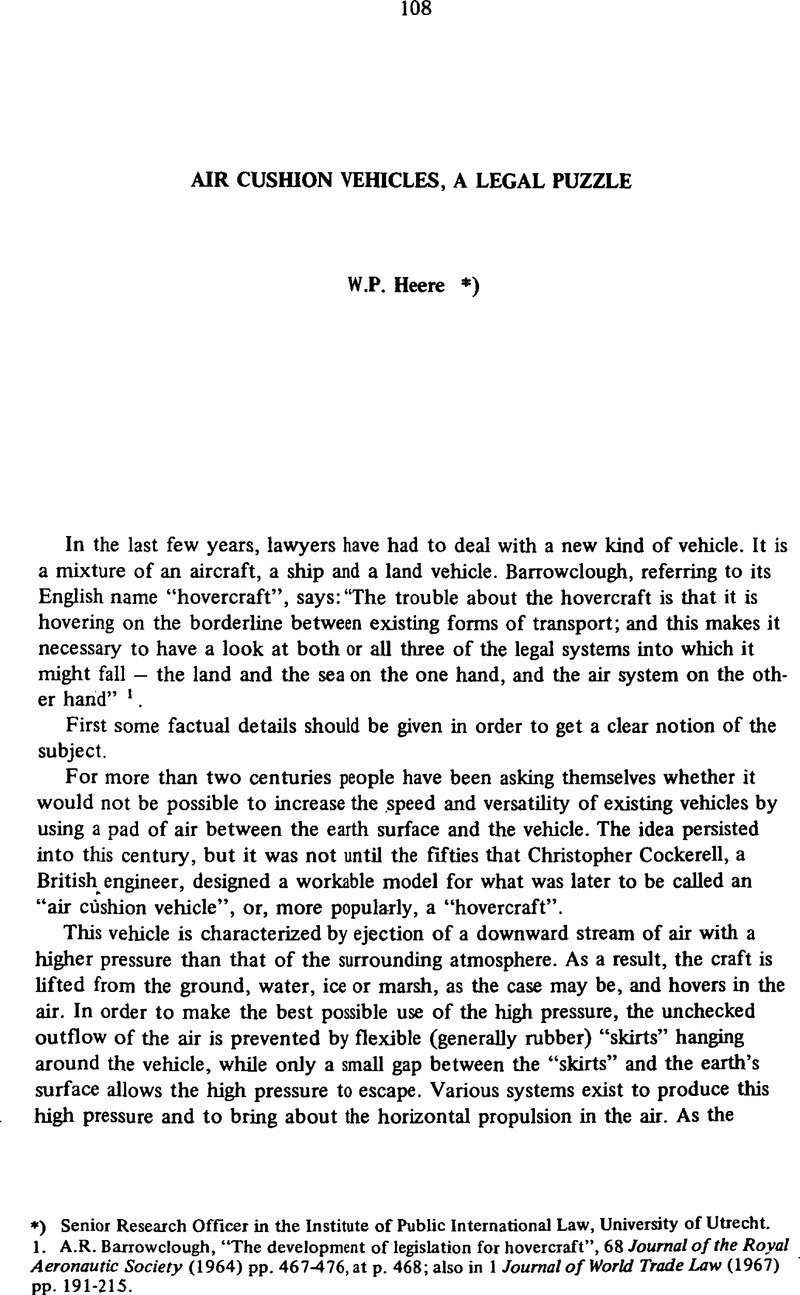Published online by Cambridge University Press: 07 July 2009

1. Barrowclough, A.R., “The development of legislation for hovercraft”, 68 Journal of the Royal Aeronautic Society (1964) pp. 467–476, at p. 468CrossRefGoogle Scholar; also in 1 Journal of World Trade Law (1967) pp. 191–215.Google Scholar
2. Sarisky, J.L., “The law and an unprecedented mode of transportation: the hovercraft”, 6 Journal of Public Law (Emory Law School, Atlanta, 1967) pp. 138–158, at p. 138.Google Scholar
3. In the Netherlands in 1969: the Harlingen-Terschelling and Den Helder-Terschelling routes. These services were suspended because of a too low passenger-rate. At present a service from Flushing to Ramsgate is being examined for its commercial viability.
4. Cf. Lφdrup, P., Hovercraft-faagel eller fisk? (Handelshögskolans i Göteborg Skrifter 1967 No. 5).Google Scholar
5. See, for example, the Govare and Bouloy drafts, infra.
6. See the U.K. legislation, infra, pp. 112–113, 115.
7. Several writers such as Barrowclough, Lφdrup, Sarisky and Tullio, have rightly emphasized that a legal regime relating to ACVs should be well thought out and must not simply consist of a gratuitous application of maritime or air law.
8. See infra p. 114.
9. du Pontavice, E., “Le statut de l'aéroglisseur”, 33 Revue générate de l'Air et de l'Espace (1970) pp. 125–157, at p. 145.Google Scholar
10. IMCO. Assembly. IVth Extraordinary Session, 26 November - 28 November 1968. Sixth Session, 15 October - 29 October 1969. Resolutions and other Decisions.
11. Pontavice, op.cit. at pp. 145–146.
12. Unofficial information.
13. Unofficial information.
14. This request is not recorded in the Report of the Conference. See, however, the report by Chauveau, P. in: Report of the 54th Conference, The Hague 1970, p. 316.Google Scholar
15. Report of the 53rd Conference, Buenos Aires 1968, p. XXI.
16. Report of the 54th Conference, The Hague 1970, pp. XI, 311, 939–940.
17. I.M.C. Documentation 1969, vol. III, pp. 154–166.
18. Reports of meetings in Zeitschrift für Luftrecht und Weltraumrechtsfragen, in particular vol. 20 (1971) p. 33, and vol. 21 (1972) p. 36.
19. Norges Lover 1682–1969, Oslo 1970, p. 2474. Paragraph 5 of the Act limits its applicability till 31 December 1970. No data of later legal developments were available.
20. Decree of 13 May 1966, referred to in Sveriges Rikes Lag, Stockholm 1970.
21. S.I. 1971 no. 720; 20 I.C.L.Q. (1971) pp. 768–769.
22. Cf. Rodière, R., Le statut des aéroglisseurs, 23 Revue Française de Droit Aerien (1969) pp. 127–135.Google Scholar
23. Projet de loi sur les aéroglisseurs, aquaplanes et autres engins similaires, mimeographed text.
24. Not recorded in the Report of the Conference.
25. 15 U.N.T.S. p. 295. Annex 7 concerns aircraft nationality and registration marks.
26. I.C.A.O., Annual Report of the Council to the Assembly for 1967, pp. 48 and 145.
27. Technically speaking the new definition applies exclusively for the purposes of Annex 7 and of Annexes 6 (Operation of aircraft) and 8 (Airworthiness of aircraft), ibid. pp. 48 and 144–145. However, it may be assumed that its consequences are much more far-reaching and that on the whole the ICAO will not concern itself with ACVs.
28. F.A.A. Circular No. 20. Cf. Sarisky, op.cit. p. 142.
29. Stb. 1969 No. 41.
30. Report of the 54th Conference, p. 326.
31. Lloyd's Register of Shipping uses the following definition: “An Air Cushion Vehicle (ACV) is […] a self-propelled vehicle which operates amphibiously or only over water, and is capable of supporting at least 75 per cent of its fully loaded weight both whilst stationary and whilst under way on one or more cushions of air. These cushions are to be continuously generated within the vehicle and are to be dependent for their effectiveness on the proximity of the surface over which the vehicle operates”. See Lloyd's Register of Shipping, Air Cushion Vehicles. Guidance, Notes and Requirements for the Classification of Air Cushion Vehicles, London1970Google Scholar. They include provisions on classification, design and construction of hull and equipment, machinery, periodical surveys, trials and safety considerations. In this context mention should be made of the fact that, having adopted a definition of ACVs and thus separating these crafts from ships, Lloyd's Shipping Register has created a special register for ACVs.
32. Tribunal de Commerce de Calais, 18 November 1969, in Syndicat Professional des Pilotes de Calais v. Société Hoverlloyd, 33 Revue générate de l'Air et del'Espace 1970 pp. 206–207.
33. In the U.S. the Treasury Department's Bureau of Customs and the U.S. Coast Guard have jurisdiction over ACVs where carriage over water is concerned.
34. Though Mankiewicz, for instance, strongly contested this at the Hague ILA Conference in 1970. Report of the 54th Conference, p. 310.
35. See the comment by the present author at the Hague ILA Conference, ibid. p. 308.
36. No official text available yet.
37. I.M.C. Documentation 1968, vol. III, p. 12; vol. IV, p. 32. In Govare's draft “luggage” includes the vehicles of passengers.
38. Convention for the Unification of Certain Rules relating to International Carriage by Air, 137. L.N.T.S. p. 11.
39. Protocol to amend the Warsaw Convention, 478 U.N.T.S. p. 371.
40. Agreement CAB No. 18900, Beaumont and Shawcross on Air Law, vol. 2, 3rd ed., London 1966, Appendix D [D 34, 35].
41. Protocol revising the Warsaw Convention Rules on Aii Carrier Liability to Passengers, 10 I.L.M. (1971) p. 613.
42. 500 U.N.T.S. p. 31.
43. Current Legal Developments, 20 I.C.L.Q. (1971) p. 769.
44. 120 L.N.T.S. p. 155.
45. I.M.C. Documentation 1968, vol. II p. 5.
46. Not recorded in the Report of the Conference.
47. 310 U.N.T.S. p. 181.
48. Notiziario di Aviazione Civile, 3 September 1970.
49. I.M.C. Documentation 1968, vol. II p. 40.
50. 310 U.N.T.S. p. 151.
51. 192 L.N.T.S. p. 289.
52. 103 B.F.S.P. pp. 434 and 441.
53. I.e. Chapters 1 and 2 of the Act of 7 July 1967 and of the Decree of 19 January 1968.